N-Vex Shapes
Erich Friedman
Math Department, Stetson University, DeLand, FL 32720
erich.friedman@stetson.edu
Let a shape be an open set in the plane. Let us define a shape S to be n-convex (or n-vex) if the closure of the union of n non-overlapping copies of S is convex. Therefore a shape is 1-vex if and only if it is convex.
Define the spectrum of S to be the set of positive integers n for which S is n-vex. A circle has spectrum {1}, and triangles and trapezoids have spectrum N={1,2,3,...}. What other sets of positive integers are the spectrum of some shape?
Theorem 1: The sets {1,2,3,...n}, {1,2,3,...n,2n} and {1,2,3,...n,2n+1} are spectra for all n.
Proof: We show that a sector of a circle with angle 2π / k has spectrum {1,2,3,... k/2
k/2 ,k} if k is an integer, and {1,2,3,...
,k} if k is an integer, and {1,2,3,... k/2
k/2 } otherwise. Sectors can only fit together into convex shapes by having straight sides completely touch another straight side. The resulting figure will be convex as long as the total angle measurement at each internal corner is less than π. If the centers of the sectors meet at one point, no more than
} otherwise. Sectors can only fit together into convex shapes by having straight sides completely touch another straight side. The resulting figure will be convex as long as the total angle measurement at each internal corner is less than π. If the centers of the sectors meet at one point, no more than  k/2
k/2 of them can be convex. If the centers of the sectors meet in two points, no more than 2
of them can be convex. If the centers of the sectors meet in two points, no more than 2 k/4
k/4 of them can be convex.
of them can be convex. 
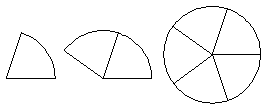 Figure 1. A shape with spectrum {1,2,5}
Figure 1. A shape with spectrum {1,2,5}
Theorem 2: The set {n} is a spectrum for all n.
Proof: Take a sector of a circle with angle 2 / n, and add and subtract semicircles from the straight sides so that n of them will fit together to make a circle.
/ n, and add and subtract semicircles from the straight sides so that n of them will fit together to make a circle. 
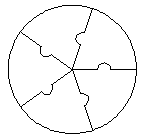 Figure 2. A shape with spectrum {5}
Figure 2. A shape with spectrum {5}
Theorem 3: The sets N, 2N, 3N, 4N, and 8N are spectra.
Proof: As already noted, a triangle or square has spectrum N. Connecting corners of an equilateral triangle or square to its center with curved, rotationally symmetric lines gives shapes with spectrum 2N, 3N, and 4N. Also, W. R. Marshall found that a square can be dissected into 8 copies of an 18-omino.
 Figure 3. Shapes with spectra 2N, 3N, and 4N
Figure 3. Shapes with spectra 2N, 3N, and 4N
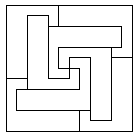 Figure 4. A shape with spectrum 8N
Figure 4. A shape with spectrum 8N
Theorem 4: The sets {2,3}, {2,4}, and {2,5} are spectra.
Proof: For n=3, 4, or 5, we can connect the center of a circle to n equally spaced points on the circumference, each with a pair of equal length line segments separated by an angle of 2 / n.
/ n. 
 Figure 5. Shapes with spectra {2,3}, {2,4}, and {2,5}
Figure 5. Shapes with spectra {2,3}, {2,4}, and {2,5}
Theorem 5: There are infinitely many spectra which include all but finitely many numbers.
Proof: Consider an nx1 affine transformation of the L tromino, where n>1. This shape tiles a 3nx2 rectangle. If n is not divisible by 3, then it also tiles a 3nxk rectangle for some odd number k, and therefore tiles a 3nxk rectangle for all sufficiently large k. Therefore its spectrum misses only finitely many numbers. By making n large enough, we can ensure that these spectra are different from previous ones. 
Theorem 6: Not all infinite spectra are ultimately periodic.
Proof: The L tromino has every number in its spectrum except for 1, 9, and odd primes. 
Polyiamonds (unions of equilateral triangles) provide many examples of interesting spectra. Figures 7 and 8 were found by Mike Reid.
 Figure 6. A shape with spectrum {2,3,4}
Figure 6. A shape with spectrum {2,3,4}
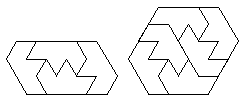 Figure 7. A shape with spectrum {4,6}
Figure 7. A shape with spectrum {4,6}
 Figure 8. A shape with spectrum N-{1}={2,3,4,...}
Figure 8. A shape with spectrum N-{1}={2,3,4,...}
 Figure 9. A shape with spectrum 2N-{2}={4,6,8,...}
Figure 9. A shape with spectrum 2N-{2}={4,6,8,...}
There are many infinite families of spectra known. By splitting the chevron above into n thinner chevrons, we get a shape with spectrum {4n,4n+2,4n+4,4n+6,...}.
Here are some more shapes with interesting spectra. Figure 10 was found by Mike Reid. Figure 11 was found by Ed Pegg.
 Figure 10. A shape with spectrum {1,3,4}
Figure 10. A shape with spectrum {1,3,4}
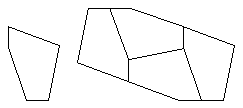 Figure 11. A shape with spectrum {1,4}
Figure 11. A shape with spectrum {1,4}
 Figure 12. A shape with spectrum {1,2,3,6,9,12,...}
Figure 12. A shape with spectrum {1,2,3,6,9,12,...}
Finding the spectrum of a given shape can often be a difficult task. No general algorithm is known. There are many other open questions:
- For which k is kN a spectrum?
- Is there a spectrum which contains 3 and 4, but not 1 or 2?
- Are all 2-element sets the spectrum of some shape?
- Are all finite sets the spectrum of some shape?
- Is there a concise classification of 2-vex or 3-vex shapes?
- Does the shape below, found by Ed Pegg, have spectrum {1,2,9,14,18}?
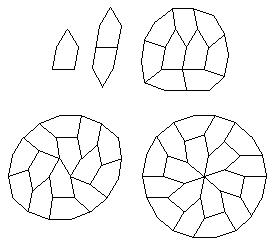 Figure 13. Does this shape have spectrum {1,2,9,14,18}?
Figure 13. Does this shape have spectrum {1,2,9,14,18}?
Acknowledgments
The author would like to thank Mike Reid, Joe DeVincentis, and Ed Pegg for many interesting e-mail discussions and suggestions.
 k/2
k/2 ,k} if k is an integer, and {1,2,3,...
,k} if k is an integer, and {1,2,3,... k/2
k/2 } otherwise. Sectors can only fit together into convex shapes by having straight sides completely touch another straight side. The resulting figure will be convex as long as the total angle measurement at each internal corner is less than π. If the centers of the sectors meet at one point, no more than
} otherwise. Sectors can only fit together into convex shapes by having straight sides completely touch another straight side. The resulting figure will be convex as long as the total angle measurement at each internal corner is less than π. If the centers of the sectors meet at one point, no more than  k/2
k/2 of them can be convex. If the centers of the sectors meet in two points, no more than 2
of them can be convex. If the centers of the sectors meet in two points, no more than 2 k/4
k/4 of them can be convex.
of them can be convex. 

 / n, and add and subtract semicircles from the straight sides so that n of them will fit together to make a circle.
/ n, and add and subtract semicircles from the straight sides so that n of them will fit together to make a circle. 










